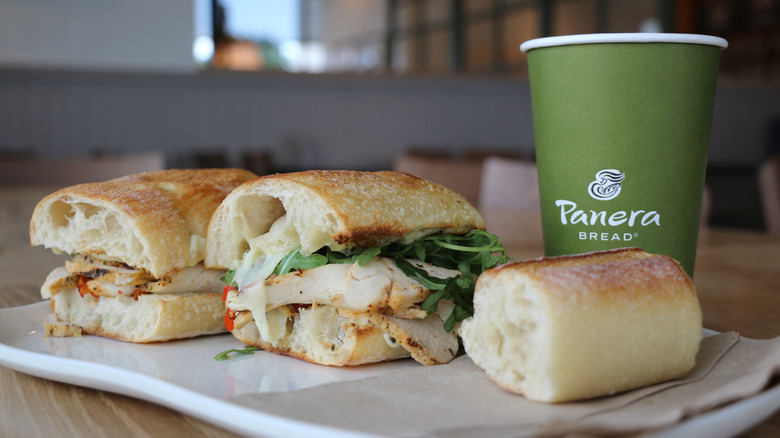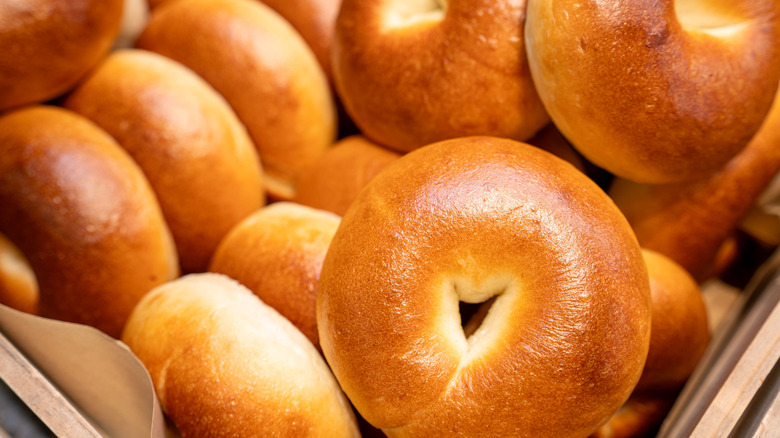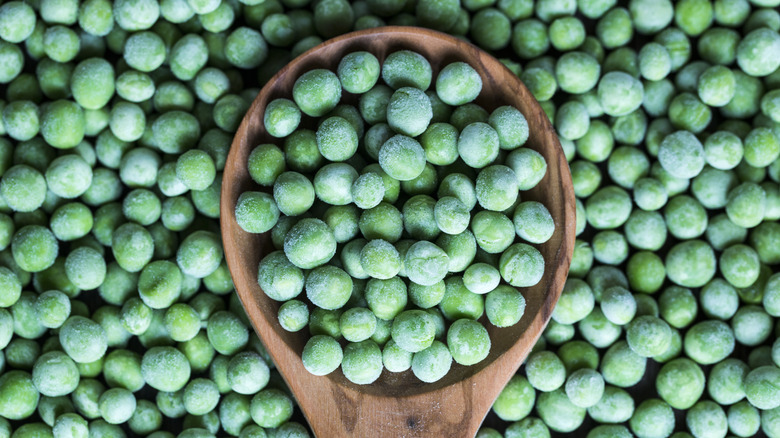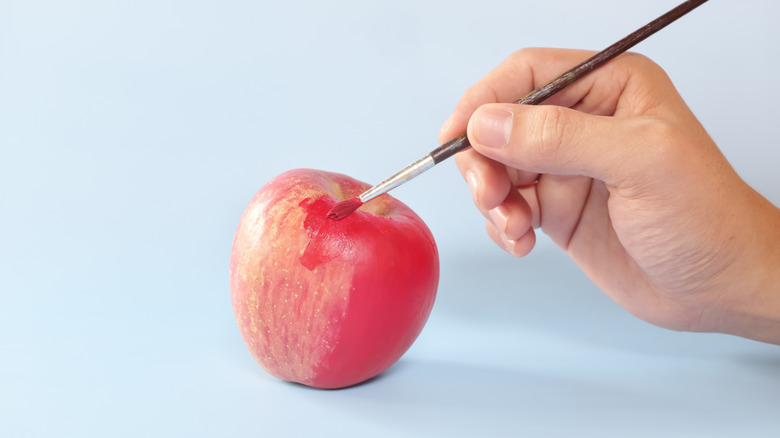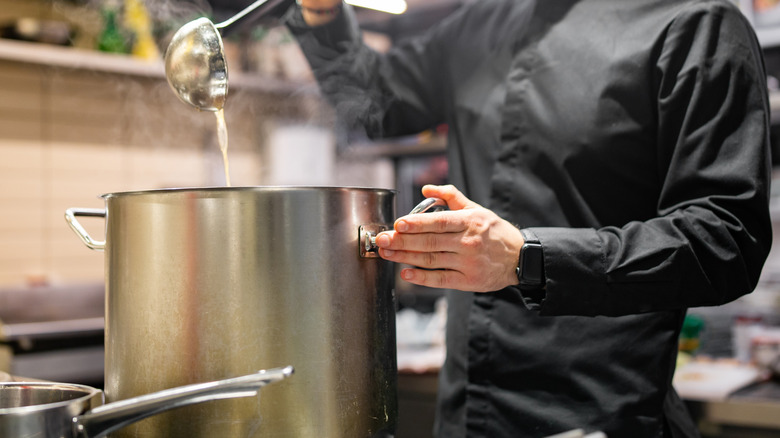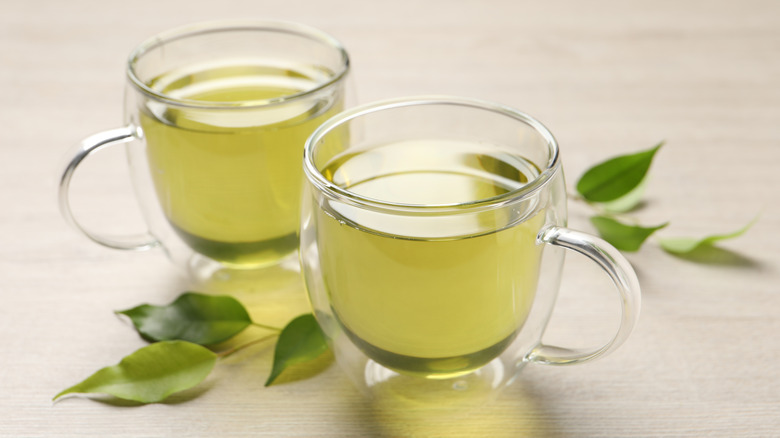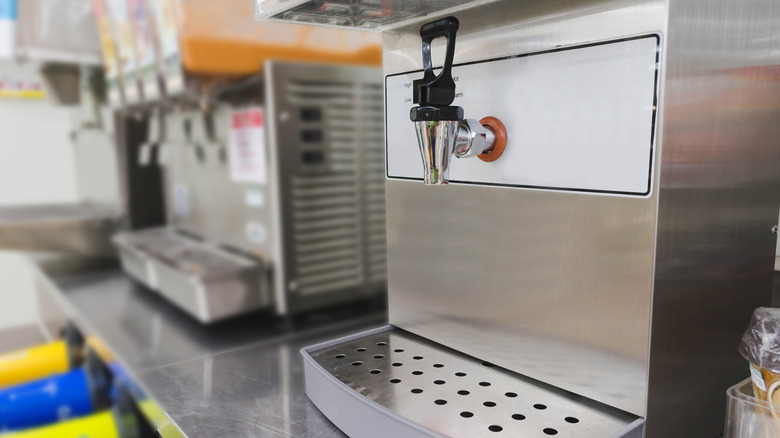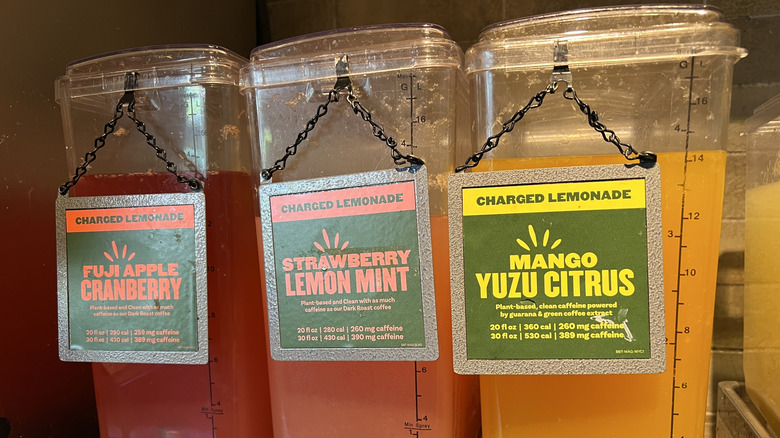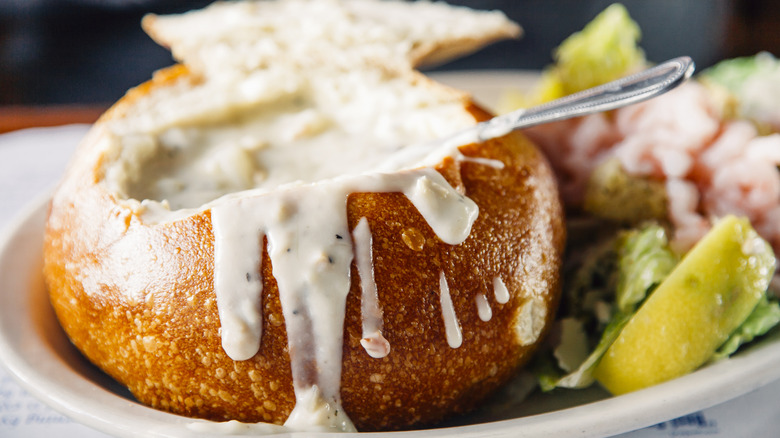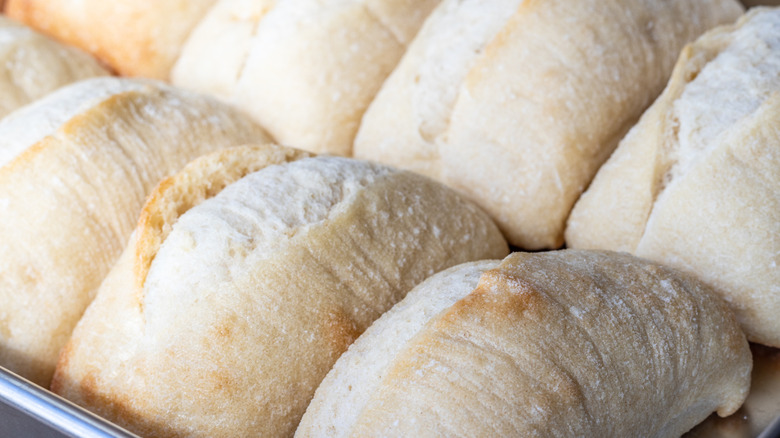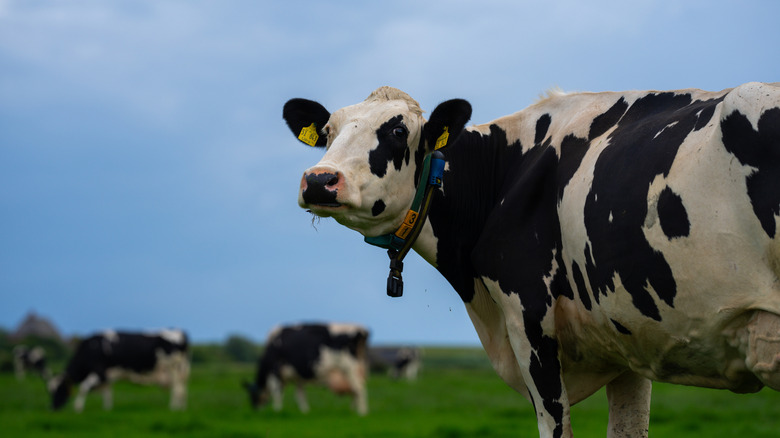The Worst Secrets Of Panera Bread Exposed
Panera has done a lot to promote eating fresh and healthy, but like any other restaurant chain, you know that there are secrets behind Panera's marketing. And Panera has plenty, although many of the secrets probably aren't that surprising. Panera is a business, after all, and many of the secrets have to do with saving money, time, and space in the restaurants.
But the company does have a few skeletons in its fresh-food closet. Some of them may not affect you, while others may make you adjust your order the next time you go to Panera for a meal. At the very least, you'll better understand what you're buying and eating, especially as the company makes significant changes to how it approaches preparing food onsite and offsite. It's better to know what's going on at your favorite restaurants anyway, so let's take a look at the worst secrets of Panera Bread exposed.
Those bagels aren't boiled
When you make bagels, you need to boil them first before placing them in the oven. A quick dip in boiling water — usually only 30 to 60 seconds per side — is enough to set the crust. That means the outer crust of the bagel becomes just cooked enough to stop the bagel dough from rising more. The longer you boil the dough, the harder the baked crust will be. The boiling step is essential for giving bagels that crispy bottom and dense interior.
Panera, however, steams its bagels before baking simply because it's easier to make them in the kitchens this way. As a result, the bagels there are not very bagel-like, and are more like round bread. People who don't know any better may like them, but for bagel aficionados, Panera's bagels just aren't it. Some may consider this to be one of the shady things of Panera's menu. They've been the subject of long rants on Reddit and a source of frustration for other bakers who get asked when they'll come out with their own version of a certain Panera bagel flavor.
It uses a lot of frozen food
Panera uses a lot of frozen food. Bread dough, soups, vegetables, even mac and cheese — those kitchens do a lot of warming up, rather than cooking from scratch. But this shouldn't be that surprising; use of frozen foods by restaurants is not a new thing at all, and it's only grown in scope since the pandemic. It makes sense; frozen food stores for a longer time than fresh food, and with supply chains still unstable from weather issues, cyber attacks, labor strikes, and political situations around the world, restaurants want to be able to buy and store food when they can.
But the use of frozen food certainly goes against people's expectations for Panera. It's one thing to store bags of frozen corn out of season, but it's quite another to find that something as simple as mac and cheese or vegetable soup is actually not made from scratch in a professional kitchen. Responses were divided, though, with some people online claiming they were shocked, and others acting like it was a bigger surprise that someone thought it was a surprise in the first place.
The food may not be that clean
One of Panera's selling points has been its commitment to "clean" food. But there's no official definition of what clean food actually means, so determining whether the food really is clean is subjective. And unfortunately, that can mean that what Panera calls its food doesn't meet your standards. This resulted in a class-action lawsuit filed against Panera in 2019, where the plaintiff claimed that Panera's food contained artificial and chemical additives. A second lawsuit brought by another customer over a similar issue was dismissed.
But Panera faced another problem in its quest to be known for its clean food. In 2019, a survey of glyphosate levels in restaurant food showed that Panera had the highest levels of glyphosate of all the restaurants tested. Glyphosate is the generic name for Roundup, and it's an herbicide that's been linked to cancer and other health issues. So, it's definitely not something you'd ever associate with clean food.
Some soup may be old soup
If you've ever gotten watery soup at Panera, especially in the morning, chances are you're eating leftover soup from the previous day. Panera isn't into food waste, so any soup that's left at the end of one day is often bagged and stored overnight. The restaurant is supposed to ensure that the soup cools adequately and is reheated safely, of course. But storing it and then reheating it, especially if any condensation forms, can make the soup more watery than you'd expect.
Sometimes the bag holding the soup can develop a small hole, such as through rough handling by employees. The reheating process can introduce water into the bag through that hole, and the soup becomes watery. If you want to be more confident that the soup you're eating is new, order it later in the day. One more possibility is that the ingredients used in the soup were originally frozen and brought in a lot of extra water when cooked.
The green tea doesn't come from tea leaves
A restaurant that claims to have fresh, healthy food should be making fresh tea, right? Not at Panera. The chain offers a passionfruit papaya green tea that customers love, and it turns out that it's not made from flavored tea leaves. It's instead made from a commercial concentrate mixed with water. The concentrate is from the Republic of Tea brand, which doesn't sell it on its retail site, but does make it available for commercial sales to businesses.
Fans of Panera first learned about this in 2021 when a TikToker who worked at Panera showed how the green tea was made. Unfortunately, making a copycat of the tea at home takes several steps as that concentrate isn't available to the public. However, it can be done if you can find a similar tea sold in bags and then make a concentrated version of it.
Those tea drink dispensers might be moldy
This one is something that not every location deals with, but some do. The drink dispensers, especially for the green tea and iced tea? You may want to reconsider using those. One report from a former employee claimed that the circulating lemonade and green tea dispensers were cleaned only once a month and had a mold problem. The mold appeared to be on the outside and not the inside of the dispensers, but that's still too close for our tastes. For years now, mold and slime on and near drink dispensers at restaurants have been a public issue, with multiple reports warning both restaurant owners and customers to be on the lookout. Any sign of mold on a machine is a bad one.
But what's worse is that some Panera locations might not have the best cleaning schedule for the drink machines' innards. One report claimed the interior of the tea container on an iced tea dispenser — something that should be cleaned nightly — was covered with some sort of gunk, as if it hadn't been cleaned in a long time. Obviously, some locations of any chain restaurant are going to be better or worse than others at keeping things clean, and Panera is no exception. So, we don't want to imply that every Panera location is like this. But at least two of them out there really needed to revamp cleaning protocols.
The Charged Lemonade caffeine scandal
So, this is likely the worst secret of Panera's, but it is changing. Unfortunately, it took at least two deaths to force the chain to remove these drinks from its menu. Panera had menu items called Charged Sips, which were drinks like lemonade that contained caffeine. The caffeine content wasn't kept secret; in fact, it was known from the menu's introduction in 2022 just how high the amount was. But it wasn't until customers started reporting being unable to sleep that the level got some attention. Unfortunately, the attention from that wasn't enough, and two wrongful death lawsuits were filed against Panera, claiming the caffeine content in the drinks was responsible for killing people with heart conditions.
One case was over the death of a man in Florida who avoided energy drinks due to high blood pressure, but drank the Charged Lemonade because it wasn't advertised as an energy drink. The other case was over the death of a college student with a known heart condition, who also avoided energy drinks as a result. She too ordered a Charged Lemonade, apparently unaware of its caffeine content. Panera announced in May 2024 that it was discontinuing the Charged Sips.
Want soup? Maybe don't get the bread bowl
If you want soup at Panera, maybe don't order it in the bread bowl. That's because the bread bowl won't get you an actual bowl of soup. Panera has two sizes of soup, a cup and a bowl. The cup is 8 ounces and the bowl is 12 ounces. And if you order a bread bowl, you'd expect to get an actual bowl of soup in that bowl, right?
Nope. The "bowl" in bread bowl apparently refers only to the use of the bread in place of a normal dish. The hollowed-out center of the bread bowl receives only a cup of soup when employees prepare it. So, if you want 12 ounces of soup but you also want a bread bowl, you'll have to order them separately. The good news is that there's no prohibition on ordering a plain bowl of soup and an empty bread bowl. You'll pay a little more because you have to pay for the two items separately, but the overall price won't increase by much.
The bread dough isn't even mixed at the store
Panera's image as a place to get freshly baked bread isn't quite accurate. Baking itself may be done at the store, but the dough for the bread — and even the cookies — is made offsite, and new changes may make the gap between the bakeries and stores even bigger. Previously, Panera would receive a lot of frozen dough that the bakers had to shape and proof before baking onsite. The dough was actually mixed at central factories. A few items also came in as par-baked goods, meaning items that were already proofed, shaped, and partially baked.
However, that could be changing. Panera is reportedly shifting toward using more par-baked goods now, instead of just frozen dough. The move would reduce the hours available to bakers at individual locations and increase the divide between Panera's image and how it actually prepare food. The changes are already being felt at some locations. One baker told Nation's Restaurant News that hours for bakers were cut from full-time shifts to part-time, sometimes as short as two hours. Shifts were also changed from overnight to during the day. Several bakers have reportedly left as a result.
It just relaxed its standards for meat
This last one might be the most annoying of all, especially if you eat at Panera because of its policies on animal welfare and antibiotics. The one saving grace (if you can call it that) is that it's not really a secret; the company sent out press releases about it in March 2024. Previously, Panera had policies about using only antibiotic-free meat as well as sourcing that meat only from cattle that were pasture-raised. The company was known for having high standards for the ingredients it used and for focusing on "clean" ingredients.
Now, that's all changed. The standards were loosened as part of a major menu overhaul that the company began as it prepared to go public. In addition to removing several recipes, the company told its restaurants to remove materials promoting things like grass-fed beef and animal welfare. Now, some pork and turkey items will be allowed to use meat that came from animals given antibiotics, and it allows the use of some meats from animals that were given feed that contained other animal products. According to a Reuters report, the changes to the meat supply are supposed to save the company $21 million per year.
